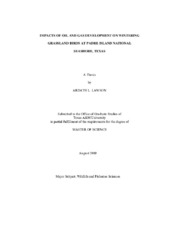| dc.description.abstract | Padre Island National Seashore provides important habitat for wintering
grassland birds, which are declining throughout their breeding range, yet oil and gas
development is widespread in the park. My objective was to evaluate the effects of
resource extraction on the park's grassland birds and make management
recommendations based on my findings.
In January-March 2007 and 2008, I surveyed 5 active, 4 abandoned, and 4 road
sites to investigate the relationship between distance from disturbance (well pads, access
roads) and bird abundance. I also compared abundance among the 3 site types. At each
site I recorded bird numbers and species in 10-m distance bands along all transects (4
transects/well, 2 transects/road), each extending 300 m from the road or pad.
At road sites bird abundance was positively correlated with increased distance
from road edge, but I found no linear relationship at active or abandoned well sites.
However, mean bird abundance in the first (0-30-m) distance interval of active well
transects was less than half that at the second interval, and was the lowest value for all
active intervals except the ninth. First-interval abundance at active wells was lower than
abundance at any abandoned well interval. Road transects likewise showed low
abundance in the initial interval, although unlike at active wells abundance increased
steadily with distance from the center of disturbance.
This trend of lower overall numbers at the first interval of active well transects
was driven largely by 1 species, the meadowlark. A combination of high noise levels
near active well pads (up to 80 dB) and lack of tall vegetation (on average 30% lower than the 60-90-m interval) from which to sing may have contributed to low numbers of
meadowlarks, which were the only birds to sing regularly during my study period.
While most birds appear to be minimally affected by resource extraction at Padre
Island, to ensure minimal impacts on sensitive species I recommend: 1) reducing noise at
active sites, 2) limiting disturbance to vegetation near pads and roads, 3) maintaining
existing perch sites, 4) restoring all vegetation to its pre-extraction condition, 5) limiting
road construction. | en |


